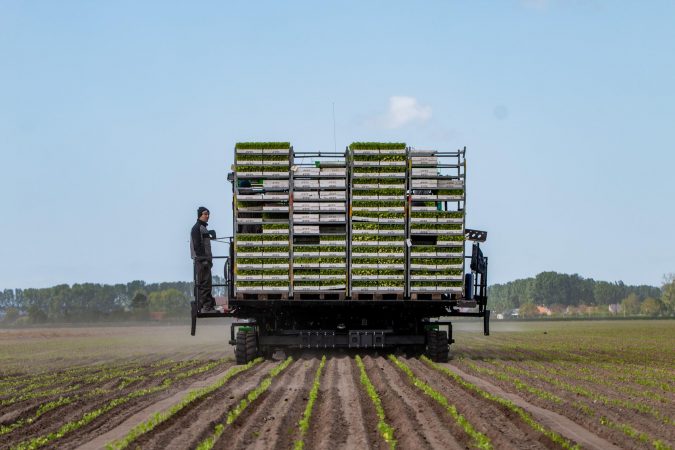The development of fully-automated transplanters for plants with a root ball is continually evolving. Belgian company Agriplant’s transplanter machines are just one example. The company spent more than 10 years developing its robotic transplanter system. Today, several of their machines are already in operation all over Europe. The company recently commissioned its largest machine in the south of the Netherlands.
Agriplant started out in the seventies. At the time, a Belgian SME called Pype imported paper pots, to facilitate the transplanting of seedlings. The company reached out to a planting machine manufacturer to devise a way of planting these paper pockets. In Belgium, seedling trays are traditionally used for this, meaning the machines needed to be customised to be able to plant these paper pot seedlings as well. As such, the machine needed to be technically adapted, in addition to ensuring compliance with European standards. Unfortunately, the market was not yet ready for automated transplanting machines at the time.
In 1998, Agriplant launched its first fully-automated planting machine for seedlings in trays and transplants with root balls. Initially these machines were imported, but the manufacturer started to develop its own models in the early 2000s. Agriplant’s engineers spent more than 10 years developing their own automated transplanting system, which is built around a robot module that lifts the plants from the tray and places them on the “sensor head”. The sensor head eliminates any root balls without a plant in them, ensuring that only root balls with seedlings are planted. In addition to the robot module, the machine has also been fitted with modules for the supply and removal of the plant trays, a module that transports the plants to the planting element and ensures the correct planting distance in the row and, finally, the planting element. The various modules on the Agriplant machines are easy to distinguish because of their green colour. Depending on the customer’s wishes, Agriplant has 8 chassis types on which the various modules can be combined to build an automated planting machine, with fixed or interchangeable row distances or different numbers of rows.
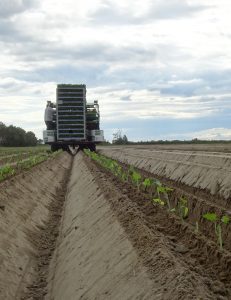 Currently, Agriplant sells machines with 1, 2, 3, 4 or 6 rows. The smallest distance between rows is 31.5 cm, for distances in row of 10 to 60 cm. The seedlings can be planted directly in the soil, in ridges or in beds. The 1-row machine plants a maximum of 14,000 plants/hour, the 6-row machine can plant up to 66,000/hour.
Currently, Agriplant sells machines with 1, 2, 3, 4 or 6 rows. The smallest distance between rows is 31.5 cm, for distances in row of 10 to 60 cm. The seedlings can be planted directly in the soil, in ridges or in beds. The 1-row machine plants a maximum of 14,000 plants/hour, the 6-row machine can plant up to 66,000/hour.
In recent years, planting machines have been used in various European countries such as Portugal, the Netherlands, Belgium, Germany, Hungary, and Italy, as well as in Canada. The transplanted crops are just as diverse as the countries in which they are grown. The main crops include cabbage, including broccoli, and Brussels sprouts, in addition to various types of celery, industrial tomatoes, onions, fennel, sweet potatoes, and herbs, which were also planted without problems.
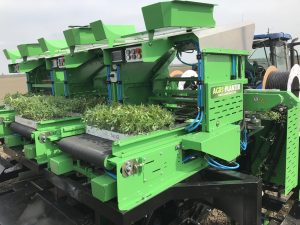 The automatic planting of vegetables saves farmers a lot of time. Compared to a manual planting machine, the speed of these machines is 4 to 5 km/hour faster. The precision in the rows also facilitates better and faster mechanical weed control. These are all decisive arguments at times when planting seasons are getting shorter and uniform crops are becoming increasingly important. Nor should the personnel costs for manual planting machines also not be underestimated for companies that must plant large areas. For one to four rows, you only need one person on the planting machine, but you’ll need two to plant six rows. The robot takes care of all the rest.
The automatic planting of vegetables saves farmers a lot of time. Compared to a manual planting machine, the speed of these machines is 4 to 5 km/hour faster. The precision in the rows also facilitates better and faster mechanical weed control. These are all decisive arguments at times when planting seasons are getting shorter and uniform crops are becoming increasingly important. Nor should the personnel costs for manual planting machines also not be underestimated for companies that must plant large areas. For one to four rows, you only need one person on the planting machine, but you’ll need two to plant six rows. The robot takes care of all the rest.
More information about Agriplant: www.agriplanter.com
6 rows at once
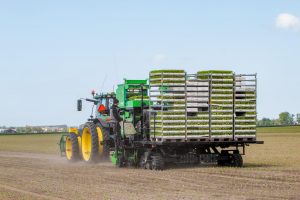 At the beginning of this year, Sluis-based Iltom BV (the Netherlands), started using an Agriplant 6SP-A 6-row planting machine. Iltom specialises in the cultivation of celeriac. The first plants are planted in March under protective foil, so the first tubers can be harvested around mid-July. In 2005, the company switched to automated transplanting. In recent years, it had been searching for a more efficient machine, which is how it ended up meeting with Agriplant. Agriplant engineers incorporated Iltom’s experiences into their design to further refine their machine.
At the beginning of this year, Sluis-based Iltom BV (the Netherlands), started using an Agriplant 6SP-A 6-row planting machine. Iltom specialises in the cultivation of celeriac. The first plants are planted in March under protective foil, so the first tubers can be harvested around mid-July. In 2005, the company switched to automated transplanting. In recent years, it had been searching for a more efficient machine, which is how it ended up meeting with Agriplant. Agriplant engineers incorporated Iltom’s experiences into their design to further refine their machine.
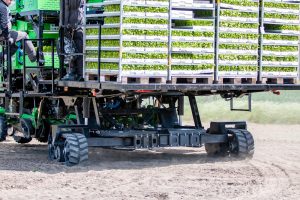 Among other things, the machine was fitted with furrow closure to be able to separately close the furrows. Besides this, the machine has a steered rear axle for better manoeuvrability on the headlands. The rear axle is fitted with Soucy tracks for minimal soil compaction between the planting beds. The planting robots are mounted stacked in pairs. The middle planting elements are staggered to the rear opposite the outer ones. The machine‘s width is thus limited to 3.5 metres. A row of tires under the drawbar evenly presses the plant bed between the tractor wheels.
Among other things, the machine was fitted with furrow closure to be able to separately close the furrows. Besides this, the machine has a steered rear axle for better manoeuvrability on the headlands. The rear axle is fitted with Soucy tracks for minimal soil compaction between the planting beds. The planting robots are mounted stacked in pairs. The middle planting elements are staggered to the rear opposite the outer ones. The machine‘s width is thus limited to 3.5 metres. A row of tires under the drawbar evenly presses the plant bed between the tractor wheels.
The machine can plant up to 66,000 celeriac plants/hour.
More information about Iltom: www.iltom.nl
Text: Antoon Vanderstraeten
Images: Antoon Vanderstraeten & manufacturer
This article appeared in Farmers of Europe Magazine nbr. 1.

